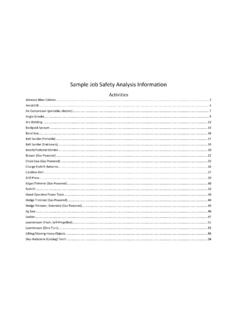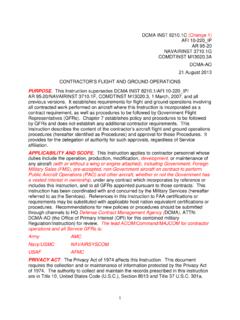Transcription of Tailgate Safety Training for Landscaping and Horticultural ...
1 Tailgate Safety Training for Landscaping and Horticultural Services English Modules Short, frequent, Safety - Training sessions keep Safety in the forefront of employee s daily routines. Employees remain interested, losses of production are minimized, and minimum preparation by the employer is needed. Frequent sessions keep Safety on the minds of employees, demonstrate concern for the employee s well being and reduce the number of employee injuries. The Training components consist of 86 short modules in both English and Spanish audience formats. English modules developed 2007 & Spanish modules developed 20008 This project is funded in whole or in part through a grant from the Occupational Safety and Health Administration, Department of Labor. Modules developed in collaboration with the Center on Education and Training for Employment at The Ohio State University OHIO STATE UNIVERSITY EXTENSION Introduction to Safety in Landscaping and Horticultural ServicesProtecting Against NoiseArc Welding SafetyProtecting Hands and FingersBattery SafetyProtecting the HeadBee, Wasp, Hornet, and Yellow Jacket StingsProtective GlovesBucket Trucks and Aerial LiftsReading Pesticide LabelsCaught In or Between ObjectsRepetitive MotionChain Saw SafetyRespirator FitChemical Skin IrritantsRollovers and Rollover Protective Structures (ROPS)
2 Chock and BlockRotary Lawn Brush and Mower SafetyChoosing Spray NozzlesSafe Operation of Portable Circular Power SawsColor CodingSafe Use of Hand Pallet Trucks and Electric CartsDust and MoldSafe Use of Flammable LiquidsElectrical ShockSafe Use of Hand-Held ToolsEquipment and Plant TransportSafe Use of Hydraulic SystemsEquipment with Cutter Bars or BladesSafe Use of JacksFederal Department of Transportation (DOT) PlacardingSafe Use of the Power-Take-OffFirst Aid KitSafe Use of Tractors and Self-Propelled EquipmentFirst on the SceneSafely Starting and Stopping a TractorForklift SafetySafety Means Slow-Moving VehicleGas WeldingSelecting a RespiratorGrounding ElectricitySkin Irritations Caused by PlantsHand Signals for Vehicle SafetySmall Engine Machine SafetyHeat StressSpider BitesHypothermia, Frostbite, and Trench FootSpraying PaintLaundering Pesticide-Contaminated ClothingStress ManagementLoading Docks and WarehousesStruck-By AccidentsLockout and TagoutSubstance Abuse and AccidentsMaterial Handling DevicesSun ExposureMaterial Safety data SheetTask LightingMixing and Spraying PesticidesThorn BushesMosquito BitesTick BitesNo Riders on Lawn EquipmentTractor Loader SafetyNon-Vented HeatersTractors, Towed Equipment.
3 And Highway SafetyOverhead Electrical HazardsTree Pruning and Ladder SafetyPersonal Eye ProtectionTree Pruning, Trimming, and Felling SafetyPesticide ExposureTrenching and Excavation SafetyPoison Ivy, Poison Oak, Poison SumacWood Chippers and ShreddersPortable Fire ExtinguishersWorkplace ViolencePower Lawn MowersPower-Take-Off (PTO) ShieldingPersonal Protection Equipment (PPE) for PesticidesPreventing Falls from TreesPreventing FallsPreventing Lifting Overexertion InjuriesPreventing Machine HazardsProper Use of LaddersProperly Cleaning and Storing RespiratorsProtecting Against Cold Module ContentsTailgate Safety Training for Landscaping and Horticultural Services, AEX-192-07 Introduction to Safety in Landscaping and Horticulture Services for Trainers and SupervisorsObjective: Explain why Safety Training is important and how it can reduce s NoteWhat makes Safety important? Who is responsible for Safety ?
4 What are some general Safety tips? For this module: Review the basic information about Safety . Provide some actual examples of Safety hazards and health risks. Ask workers to share their own experiences. Present and discuss general Safety tips. Review the important points. Have workers take the True/False quiz to check their the United States, the green industries rank high in work-related fatalities. Many accidents involve some type of machinery or equipment. Most accidents are predictable and preventable. Illnesses and health problems can also occur easily green industry work involves exposure to weather and natural hazards and dangerous chemicals. Workers in the green industries must learn and practice safe working Cost Time and MoneyAccidents cause injuries and, sometimes, even death. They involve intangible losses. You will lose time while you recover. Medical and therapy bills will add up.
5 Worst of all, you might not be able to work as you did before the accident. Safety is too expensive not to be taken seriously. Accident costs reduce the profit margin. In the worst cases, accidents cost Risk Your Health?A bee sting is unpleasant at least, and it can be fatal. Pesticides and caustic chemicals can cause long-term, serious health problems. Dust and mold can cause chronic lung problems. The hot summer sun can cause sun-stroke and heat exhaustion, and winter can cause frostbite. How can you avoid those health risks? AEX Safety Program, 590 Woody Hayes Drive, Columbus, OH 43210 Safety Is Everyone s ResponsibilityIt is up to workers in the green industries to use safe working practices. All workers can contribute to each other s Safety . Remember machinery operators aren t the only ones who get hurt in Tips for a Safe Working Environment A good Safety program starts with a Safety status assessment.
6 Make Safety everyone's concern. This includes family, workers, visitors, and you. Be aware of what you are doing and your surroundings. Most injuries happen during routine, everyday tasks. Sometimes, you cannot handle a task alone. If you can t, ask for help. Take short rest breaks. Don't over-exert yourself don t get so tired you get careless. Get plenty of sleep. Stay away from equipment if you are angry. Wait a little while until you cool down. Train new equipment operators before they work on their own. Read the operator's manual for all equipment. Wear the proper Personal Protection Equipment for everyday tasks and for specific jobs. You may need protective footwear with ankle support. You may also need close-fitting more information, refer to the other modules in this series, Tailgate Safety Training for Landscaping and Horticultural Services. They are listed below, organized in some basic to Safety in Landscaping and Horticultural ServicesCaught-In or Caught-Between AccidentsColor CodingFirst Aid KitsFirst on the SceneNon-Vented HeatersPreventing FallsProper Use of LaddersSpraying PaintStress ManagementStruck-By AccidentsSubstance Abuse and AccidentsTask LightingTrenching and Excavation SafetyWorkplace ViolenceVehicle SafetyFederal Department of Transportation (DOT) PlacardingHand Signals for Vehicle SafetyRollovers and Rollover Protective Structures (ROPS)Safe Use of Tractors and Self-Propelled EquipmentSafely Starting and Stopping a TractorSafety Means SMV (Slow Moving Vehicle)Tractors, Towed Equipment, and Highway SafetyPesticidesChemical Skin IrritantsChoosing Spray NozzlesAEX (continued)Laundering Pesticide-Contaminated ClothingMaterial Safety data sheet (MSDS)
7 Mixing and Spraying PesticidesPesticide ExposurePersonal Protection Equipment (PPE) for PesticidesProperly Cleaning and Storing RespiratorsReading Pesticide LabelsRespirator FitSelecting a RespiratorLawn EquipmentNo Riders on Lawn EquipmentPower Lawn MowersRotary Lawn and Brush Mower SafetyEquipment with Cutter Bars or BladesTools and MachineryArc Welding SafetyBattery SafetyChain Saw SafetyChock and BlockGas Welding SafetyLockout and TagoutPower-Take-Off (PTO) ShieldingPreventing Machine HazardsSafe Operation of Portable Circular Power SawsSafe Use of Hand-Held ToolsSafe Use of Hydraulic SystemsSafe Use of JacksSafe Use of the Power-Take-Off (PTO)Small Engine Machine SafetyWood Chippers and ShreddersTreesBucket Trucks and Aerial LiftsPreventing Falls from TreesTree Pruning and Ladder SafetyTree Pruning, Trimming, and Felling SafetyPersonal ProtectionPersonal Eye ProtectionProtecting Against NoiseProtecting Hands and FingersProtecting the HeadProtective GlovesRepetitive MotionElectricity and FireElectrical ShockGrounding ElectricityOverhead Electrical HazardsPortable Fire ExtinguishersSafe Use of Flammable LiquidsAEX HandlingEquipment and Plant TransportForklift SafetyLoading Docks and WarehousesMaterial Handling DevicesPreventing Lifting and Over-Exertion InjuriesSafe Use of Hand Pallet Trucks and Electric Carts Tractor Loader SafetyWeather and Natural HazardsBee, Wasp, Hornet, and Yellow Jacket StingsDust and MoldHeat StressHypothermia, Frostbite, and Trench FootMosquito BitesPoison Ivy, Poison Oak.
8 And Poison SumacProtecting Against ColdSkin Irritations Caused by PlantsSpider BitesSun ExposureThorn Bushes Tick BitesReview These Important Points There are many work-related accidents in landscape and Horticultural services. Safety is everyone's responsibility. Safety is too expensive to learn by accident. Accidents have many major costs. You can make the working environment safer by following a few simple Safety measures. About These ModulesThe author team for the Training modules in the landscape and Horticultural Tailgate Training series includes Dee Jepsen, Program Director, Agricultural Safety and Health, Ohio State University Extension; Michael Wonacott, Research Specialist, Vocational Education; Peter Ling, Greenhouse Specialist; and Thomas Bean, Agricultural Safety Specialist. Modules were developed with funding from the Occupational Safety and Health Administration, Department of Labor, Grant Number opinions, findings, conclusions, or recommendations expressed in this publication are those of the author(s) and do not necessarily reflect the views of the Department of Agriculture or the Department of Key: 1 = F, 2 = T, 3 = T, 4 = T, 5 = Extension embraces human diversity and is committed to ensuring that all educational programs conducted by Ohio State University Extension are available to clientele on a nondiscriminatory basis without regard to race, color, age, gender identity or expression, disability, religion, sexual orientation, national origin, or veteran L.
9 Smith, Associate Vice President for Agricultural Administration and Director, Ohio State University ExtensionTDD No. 800-589-8292 (Ohio only) or 614-292-1868 Copyright 2006, The Ohio State UniversityAEX to Safety in Landscaping and Horticulture ServicesName_____True or False?1. Only machinery operators need to worry about Safety . T F2. Green industry jobs have a high number of work-related fatalities. T F3. The first step in a landscape and Horticultural Safety program is a Safety status assessment. T F4. Accident costs reduce the profit margin of your operation. T F5. Wearing the proper PPE is only important if you are working with pesticides. T FCopyright 2006, The Ohio State University AEX Safety Program, 590 Woody Hayes Drive, Columbus, OH 43210 Arc Welding Safety for Trainers and SupervisorsObjective: Using safe arc welding s NoteIt is important to weld using Safety precautions.
10 There are many dangers related to welding. For this module: Review the information below on the hazards of arc welding and Safety practices to avoid them. Demonstrate how to use Personal Protection Equipment (PPE). Have workers try on personal protection equipment. Review the important points. Have workers take the True/False quiz to check their welding includes shielded metal-arc, gas-shielded, and resistance welding. Arc welding equipment var-ies in size and type, so it is important to read and follow the manufacturer s Arc Welding Safety Read all warning labels and instruction manuals, especially if this is the first time you re using the equip-ment. Proper eye protection is mandatory. Before starting any welding, make a complete inspection of the welder. Remove all potential fire hazards from the welding area. Always have a fire extinguisher ready. Equip welding machines with power disconnect switches for quick shut off.


